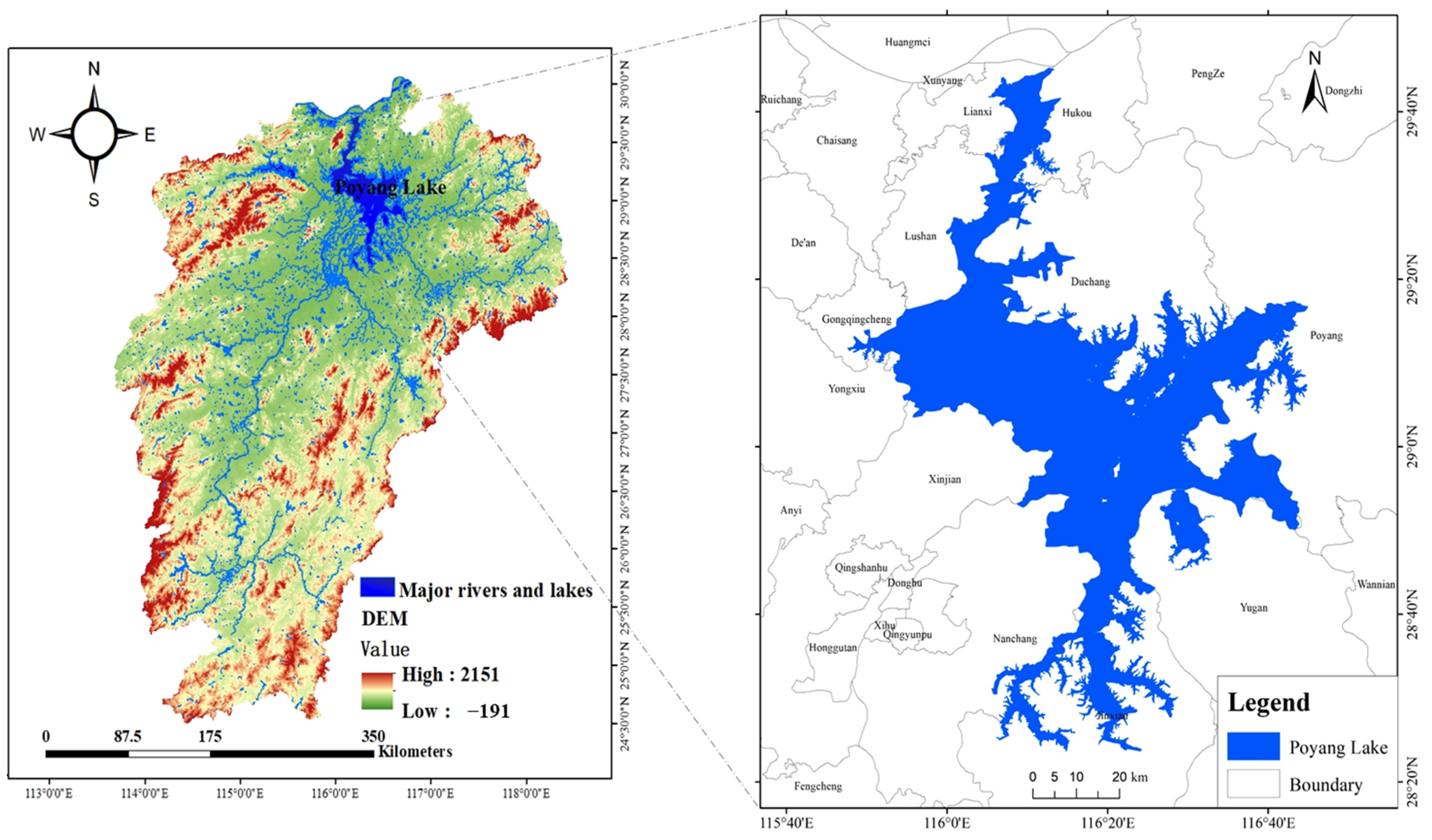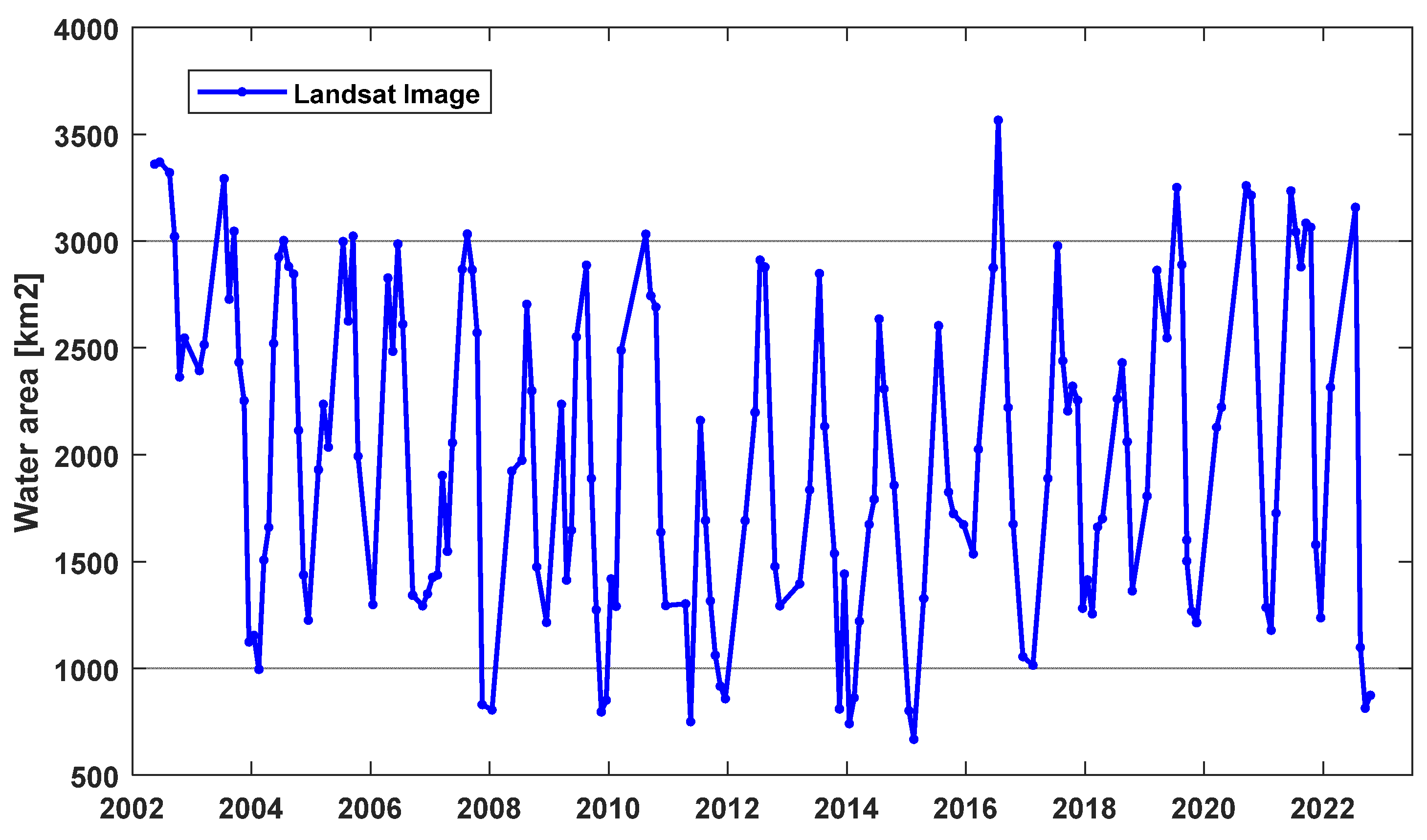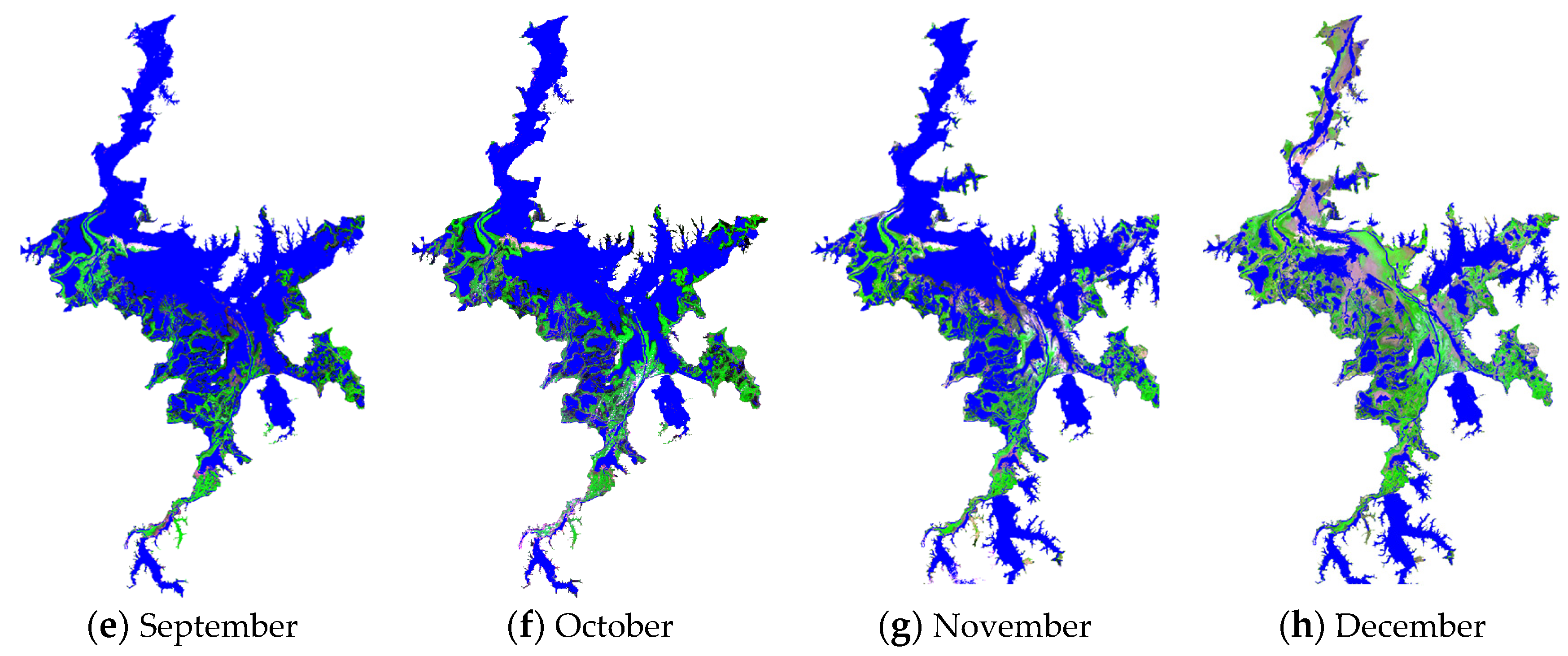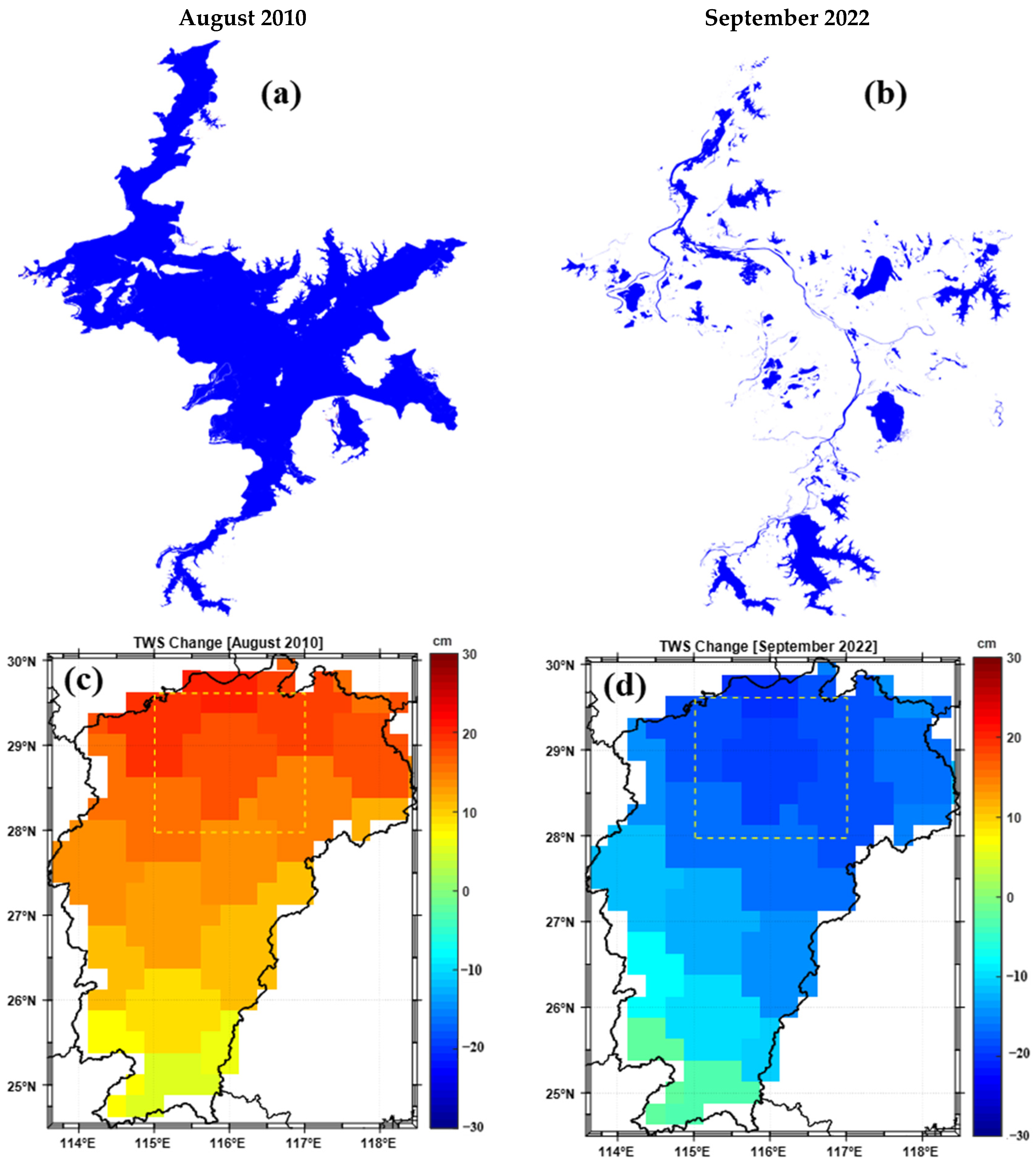Dynamic Monitoring of Poyang Lake Water Area and Storage Changes from 2002 to 2022 via Remote Sensing and Satellite Gravimetry Techniques
Abstract
1. Introduction
2. Study Area, Employed Datasets and Processing Methods
2.1. Study Area
2.2. Landsat Imagery and Processing Methods
2.3. GRACE and GRACE-FO Mascon Solutions
3. Results and Analysis
3.1. Changes in the Water Area of Poyang Lake
3.2. Changes in the Terrestrial Water Storage of Poyang Lake
4. Conclusions
Author Contributions
Funding
Data Availability Statement
Acknowledgments
Conflicts of Interest
References
- Balsamo, G.; Salgado, R.; Dutra, E.; Boussetta, S.; Stockdale, T.; Potes, M. On the contribution of lakes in predicting near-surface temperature in a global weather forecasting model. Tellus A Dyn. Meteorol. Oceanogr. 2012, 64, 15829. [Google Scholar] [CrossRef]
- Long, Z.; Perrie, W.; Gyakum, J.; Caya, D.; Laprise, R. Northern Lake impacts on local seasonal climate. J. Hydrometeorol. 2007, 8, 881–896. [Google Scholar] [CrossRef]
- Zan, Y.; Gao, Y.; Jiang, Y.; Pan, Y.; Li, X.; Su, P. The Effects of Lake Level and Area Changes of Poyang Lake on the Local Weather. Atmosphere 2022, 13, 1490. [Google Scholar] [CrossRef]
- Rosenberry, D.O.; Lewandowski, J.; Meinikmann, K.; Nützmann, G. Groundwater–the Disregarded Component in Lake Water and Nutrient Budgets. Part 1: Effects of Groundwater on Hydrology. Hydrol. Process. 2015, 29, 2895–2921. [Google Scholar] [CrossRef]
- Lima-Quispe, N.; Escobar, M.; Wickel, A.J.; von Kaenel, M.; Purkey, D. Untangling the Effects of Climate Variability and Irrigation Management on Water Levels in Lakes Titicaca and Poopó. J. Hydrol. Reg. Stud. 2021, 37, 100927. [Google Scholar] [CrossRef]
- Vaheddoost, B.; Aksoy, H. Interaction of Groundwater with Lake Urmia in Iran. Hydrol. Process. 2018, 32, 3283–3295. [Google Scholar] [CrossRef]
- Zhang, T.; Ren, H.; Qin, Q.; Zhang, C.; Sun, Y. Surface Water Extraction from Landsat 8 OLI Imagery Using the LBV Transformation. IEEE J. Sel. Top. Appl. Earth Obs. Remote Sens. 2017, 10, 4417–4429. [Google Scholar] [CrossRef]
- Tian, B.; Gao, P.; Mu, X.; Zhao, G. Water Area Variation and River–Lake Interactions in the Poyang Lake from 1977–2021. Remote Sens. 2023, 15, 600. [Google Scholar] [CrossRef]
- Zuo, J.; Jiang, W.; Li, Q.; Du, Y. Remote sensing dynamic monitoring of the flood season area of Poyang Lake over the past two decades. In Natural Hazards Research; Elsevier: Amsterdam, The Netherlands, 2024. [Google Scholar] [CrossRef]
- Min, Q.; Zhan, L. Characteristics of Low-Water Level Changes in Lake Poyang during 1952–2011. J. Lake Sci. 2012, 24, 675–678. [Google Scholar]
- Ye, X.; Li, Y.; Li, X.; Zhang, Q. Factors Influencing Water Level Changes in China’s Largest Freshwater Lake, Poyang Lake, in the Past 50 Years. Water Int. 2014, 39, 983–999. [Google Scholar] [CrossRef]
- Li, H.; Zhang, H.; Yu, L.; Cao, K.; Wang, D.; Duan, X.; Ding, F.; Mao, Z.; Wang, K.; Liu, S.; et al. Managing Water Level for Large Migratory Fish at the Poyang Lake Outlet: Implications Based on Habitat Suitability and Connectivity. Water 2022, 14, 2076. [Google Scholar] [CrossRef]
- Cai, X.; Feng, L.; Wang, Y.; Chen, X. Influence of the three gorges project on the water resource components of Poyang lake watershed: Observations from TRMM and grace. In Advances in Meteorology; Wiley Online Library: Hoboken, NJ, USA, 2015. [Google Scholar] [CrossRef]
- Chen, Y.; Huang, Y.; Guo, R.; Zhong, X. Based on TM image monitoring the Area of Poyang Lake Changed Dynamically in 2013-2016. Comput. Eng. Softw. 2019, 40, 179–184. (In Chinese) [Google Scholar]
- Frazier, P.S.; Page, K.J. Water body detection and delineation with Landsat TM data. Photogramm. Eng. Remote Sens. 2000, 66, 1461–1467. [Google Scholar]
- Tapley, B.; Bettadpur, S.; Ries, J.; Thompson, P.; Watkins, M. GRACE measurements of mass variability in the Earth system. Science 2004, 305, 503–505. [Google Scholar] [CrossRef] [PubMed]
- Tapley, B.D.; Watkins, M.M.; Flechtner, F.; Reigber, C.; Bettadpur, S.; Rodell, M.; Sasgen, I.; Famiglietti, J.S.; Landerer, F.W.; Chambers, D.P.; et al. Contributions of GRACE to understanding climate change. Nat. Clim. Change 2019, 9, 358–369. [Google Scholar] [CrossRef] [PubMed]
- Landerer, F.; Flechtner, F.; Save, H.; Webb, F.H.; Bandikova, T.; Bertiger, W.I.; Bettadpur, S.V.; Byun, S.H.; Dahle, C.; Dobslaw, H.; et al. Extending the global mass change data record: GRACE Follow-On in-strument and science data performance. Geophys. Res. Lett. 2020, 47, e2020GL088306. [Google Scholar] [CrossRef]
- Xu, Y.; Li, J.; Wang, J.; Chen, J.; Liu, Y.; Ni, S.; Zhang, Z.; Ke, C. Assessing water storage changes of Lake Poyang from multi-mission satellite data and hydrological models. J. Hydrol. 2020, 590, 125229. [Google Scholar] [CrossRef]
- Huan, C.; Lu, T.; Zhou, S.; Wang, F.; Wu, Z. Monitoring terrestrial water storage changes and drought in Jiangxi Province using GRACE and GRACE Follow-on data. Acta Geodyn. Geomater. 2023, 20, 111–120. [Google Scholar] [CrossRef]
- Save, H. CSR GRACE and GRACE-FO RL06 Mascon Solutions v02. 2020. Available online: https://www2.csr.utexas.edu/grace/RL06_mascons.html (accessed on 20 April 2024).
- Save, H.; Bettadpur, S.; Tapley, B.D. High resolution CSR GRACE RL05 mascons. J. Geophys. Res. Solid Earth 2016, 121, 7547–7569. [Google Scholar] [CrossRef]
- Watkins, M.M.; Wiese, D.N.; Yuan, D.-N.; Boening, C.; Landerer, F.W. Improved methods for observing Earth’s time variable mass distribution with GRACE using spherical cap mascons. J. Geophys. Res. Solid Earth 2015, 120, 2648–2671. [Google Scholar] [CrossRef]
- Wiese, D.N.; Landerer, F.W.; Watkins, M.M. Quantifying and reducing leakage errors in the JPL RL05M GRACE mascon solution. Water Resour. Res. 2016, 52, 7490–7502. [Google Scholar] [CrossRef]
- Loomis, B.D.; Luthcke, S.B.; Sabaka, T.J. Regularization and error characterization of GRACE mascons. J. Geod. 2019, 93, 1381–1398. [Google Scholar] [CrossRef] [PubMed]
- Landerer, F. Monthly Estimates of Degree-1 (geocenter) Gravity Coefficients, Generated from GRACE (04-2002-06/2017) and GRACE-FO (06/2018 Onward) RL06 Solutions, GRACE Technical Note 13, The GRACE Project, NASA Jet Propulsion Labor-atory. Available online: https://podaac-tools.jpl.nasa.gov/drive/files/allData/grace/docs (accessed on 20 April 2024).
- Peltier, R.W.; Argus, D.F.; Drummond, R. Comment on “an assessment of the ICE-6G_C (VM5a) glacial isostatic adjustment model” by Purcell et al. J. Geophys. Res. Solid Earth 2018, 123, 2019–2028. [Google Scholar] [CrossRef]
- Zeng, Z.Y. A new method of data transformation for satellite images: I. Methodology and transformation equations for TM images. Int. J. Remote Sens. 2007, 28, 4095–4124. [Google Scholar] [CrossRef]
- McFeeters, S.K. The Use of the Normalized Difference Water Index (NDWI) in the delineation of open water features. Int. J. Remote Sens. 1996, 17, 1425–1432. [Google Scholar] [CrossRef]
- Xu, H. Modification of Normalised Difference Water Index (NDWI) to enhance open water features in remotely sensed imagery. Int. J. Remote Sens. 2006, 27, 3025–3033. [Google Scholar] [CrossRef]
- Tri, D.A.; Dong, H.L.; In, T.Y.; Jae, K.L. Identification of Water Bodies in a Landsat 8 OLI Image Using a J48 Decision Tree. Sensors 2016, 16, 1075. [Google Scholar] [CrossRef]
- Kareem, H.; Attaee, M.; Omran, A. Estimation the Water Ratio Index (WRI) and Automated Water Extraction Index (AWEI) of Bath in The United Kingdom Using Remote Sensing Technology of The Multispectral Data of Landsat 8-Oli. Water Conserv. Manag. 2024, 8, 125–132. [Google Scholar]






| Sensor | Path | Row | Resolution | Images |
|---|---|---|---|---|
| Landsat 5 | 121 | 40 | 30 m | 52 |
| Landsat 7 | 121 | 40 | 30 m | 119 |
| Landsat 8 | 121 | 40 | 30 m | 51 |
| Landsat 9 | 121 | 40 | 30 m | 2 |
| Index | Equation | References |
|---|---|---|
| Normalized difference water index (NDWI) | NDWI = (Green − NIR)/(Green + NIR) | McFeeters [29] |
| Modified normalized difference water index (MNDWI) | MNDWI = (Green − SWIR1)/(Green + SWIR1) | Xu [30] |
| Automated water extraction index (AWEI) | AWEI = 4 × (Green − SWIR1) − (0.25 × NIR + 2.75 × SWIR2) | Tri [31]; Hayder et al. [32] |
| Image Data/Sensor | Water Extraction Method | OA | OR | CR | KC |
|---|---|---|---|---|---|
| Landsat 5/TM | Decision tree | 97.1826 | 1.16 | 2.35 | 0.9318 |
| NDWI | 94.9953 | 7.01 | 0.22 | 0.8869 | |
| MNDWI | 90.8240 | 0.17 | 10.67 | 0.8035 | |
| AWEI | 97.0832 | 0.02 | 4.01 | 0.9293 | |
| Landsat 7/ETM | Decision tree | 98.8947 | 0.07 | 1.36 | 0.9689 |
| NDWI | 97.0126 | 0.09 | 2.14 | 0.9051 | |
| MNDWI | 95.4329 | 0.19 | 5.64 | 0.8643 | |
| AWEI | 96.3277 | 0.04 | 4.58 | 0.8924 | |
| Landsat 8/OLI | Decision tree | 98.9779 | 1.88 | 7.43 | 0.9469 |
| NDWI | 98.5658 | 11.14 | 2.5 | 0.9204 | |
| MNDWI | 98.8364 | 2.85 | 7.83 | 0.9395 | |
| AWEI | 98.8686 | 6.46 | 4.43 | 0.9392 | |
| Landsat 9/OLI2 | Decision tree | 93.0039 | 3.53 | 5.80 | 0.9149 |
| NDWI | 90.8785 | 0.08 | 10.94 | 0.8145 | |
| MNDWI | 91.4032 | 0.34 | 10.06 | 0.8299 | |
| AWEI | 92.1592 | 0.42 | 9.28 | 0.8572 |
| Index | Annual Amplitude [cm] Phase [deg] | Semi-Annual Amplitude [cm] Phase [deg] | Linear Trend [cm/year] |
|---|---|---|---|
| CSR RL06 | [10.06 ± 0.48] [176.2 ± 4.9] | [3.32 ± 0.46] [47.3 ± 23.0] | 0.20 ± 0.05 |
| JPL RL06 | [10.02 ± 0.48] [173.3 ± 5.1] | [3.06 ± 0.47] [58.5 ± 17.7] | 0.15 ± 0.05 |
| GSFC RL06 | [13.10 ± 0.39] [176.6 ± 3.3] | [1.95 ± 0.38] [44.6 ± 3.40] | 0.23 ± 0.04 |
| Mean (CSR, JPL, GSFC) | [11.30 ± 0.44] [175.5 ± 4.2] | [2.76 ± 0.42] [50.7 ± 19.9] | 0.19 ± 0.05 |
| Index | CSR | JPL | GSFC | Landsat |
|---|---|---|---|---|
| CSR | 1 | 0.96 | 0.95 | 0.75 |
| JPL | 0.96 | 1 | 0.94 | 0.78 |
| GSFC | 0.95 | 0.94 | 1 | 0.76 |
| Landsat | 0.75 | 0.78 | 0.76 | 1 |
Disclaimer/Publisher’s Note: The statements, opinions and data contained in all publications are solely those of the individual author(s) and contributor(s) and not of MDPI and/or the editor(s). MDPI and/or the editor(s) disclaim responsibility for any injury to people or property resulting from any ideas, methods, instructions or products referred to in the content. |
© 2024 by the authors. Licensee MDPI, Basel, Switzerland. This article is an open access article distributed under the terms and conditions of the Creative Commons Attribution (CC BY) license (https://creativecommons.org/licenses/by/4.0/).
Share and Cite
Wang, F.; Zhou, Q.; Gao, H.; Wen, Y.; Zhou, S. Dynamic Monitoring of Poyang Lake Water Area and Storage Changes from 2002 to 2022 via Remote Sensing and Satellite Gravimetry Techniques. Remote Sens. 2024, 16, 2408. https://doi.org/10.3390/rs16132408
Wang F, Zhou Q, Gao H, Wen Y, Zhou S. Dynamic Monitoring of Poyang Lake Water Area and Storage Changes from 2002 to 2022 via Remote Sensing and Satellite Gravimetry Techniques. Remote Sensing. 2024; 16(13):2408. https://doi.org/10.3390/rs16132408
Chicago/Turabian StyleWang, Fengwei, Qing Zhou, Haipeng Gao, Yanlin Wen, and Shijian Zhou. 2024. "Dynamic Monitoring of Poyang Lake Water Area and Storage Changes from 2002 to 2022 via Remote Sensing and Satellite Gravimetry Techniques" Remote Sensing 16, no. 13: 2408. https://doi.org/10.3390/rs16132408
APA StyleWang, F., Zhou, Q., Gao, H., Wen, Y., & Zhou, S. (2024). Dynamic Monitoring of Poyang Lake Water Area and Storage Changes from 2002 to 2022 via Remote Sensing and Satellite Gravimetry Techniques. Remote Sensing, 16(13), 2408. https://doi.org/10.3390/rs16132408





